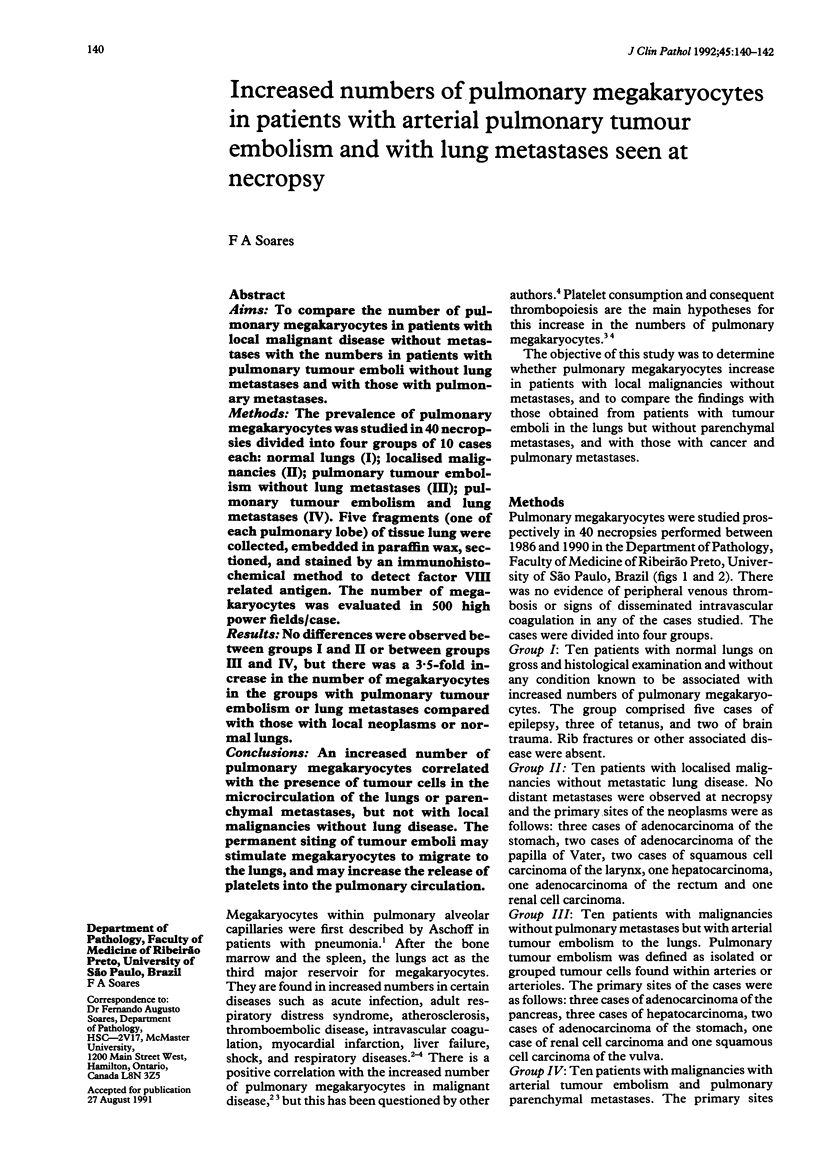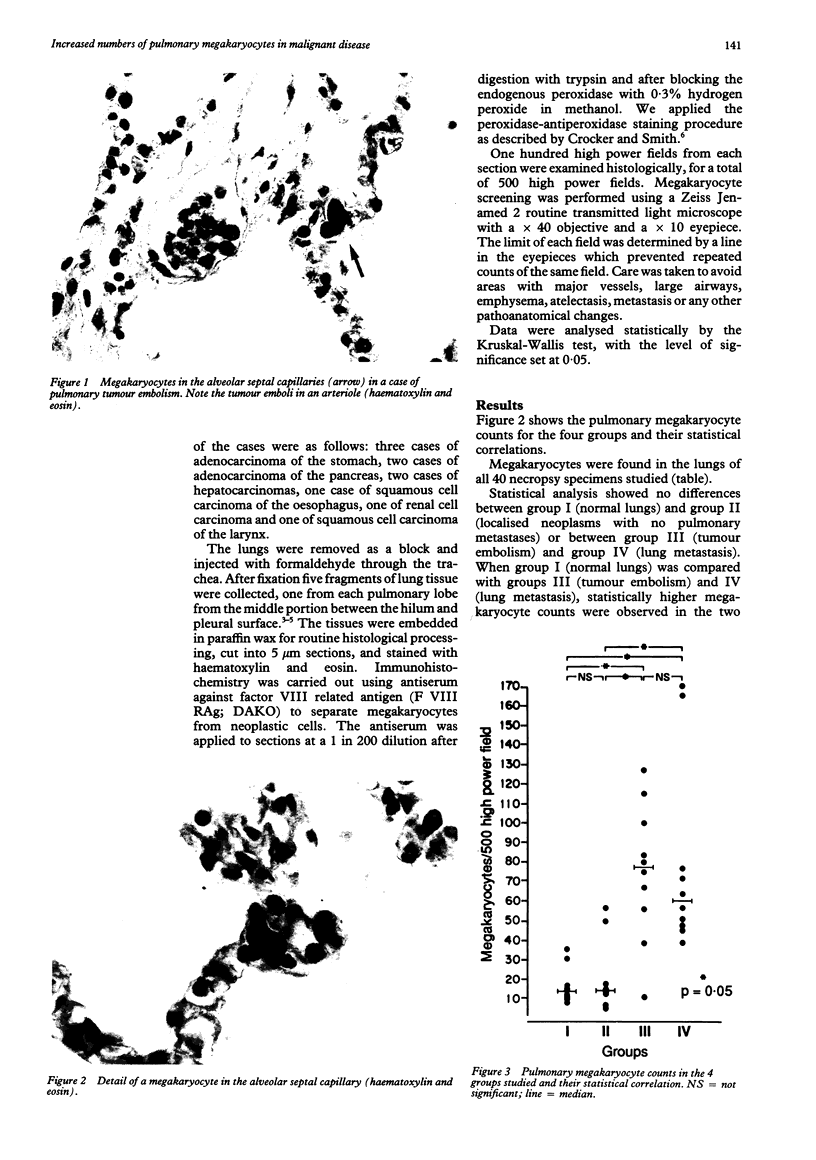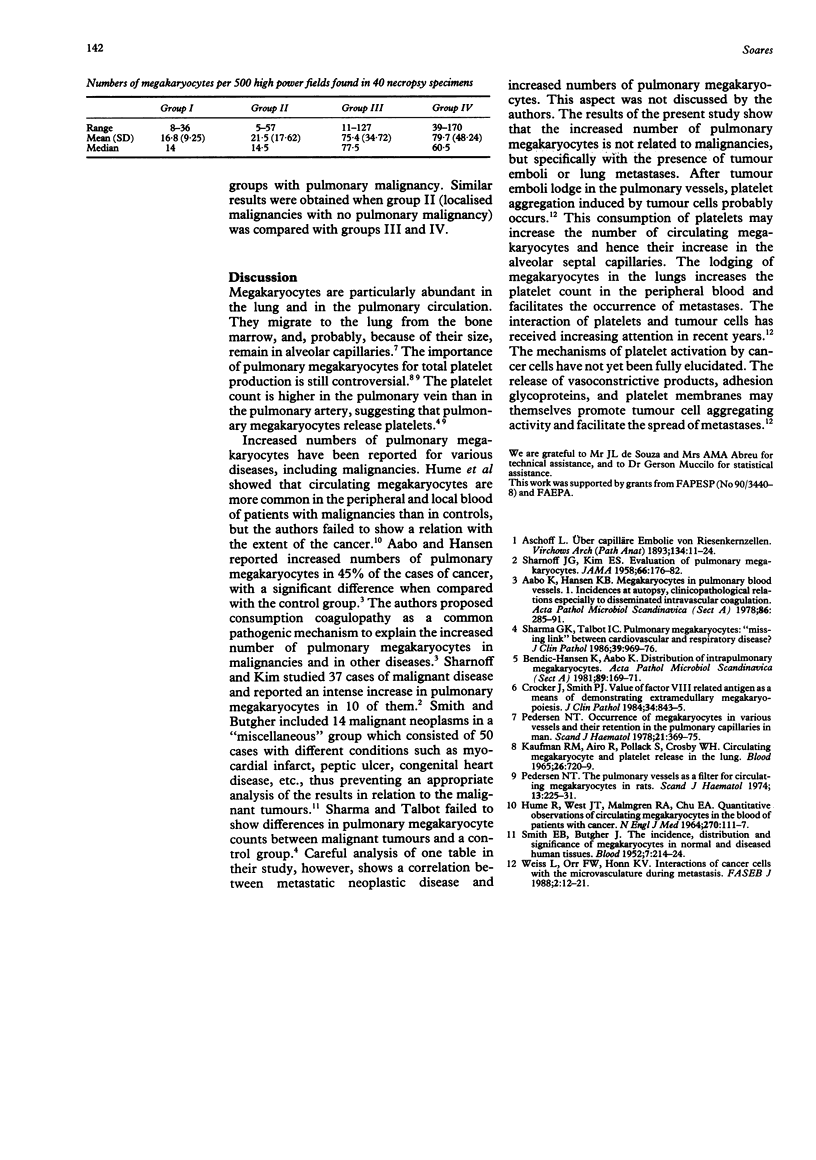Abstract
AIMS: To compare the number of pulmonary megakaryocytes in patients with local malignant disease without metastases with the numbers in patients with pulmonary tumour emboli without lung metastases and with those with pulmonary metastases. METHODS: The prevalence of pulmonary megakaryocytes was studied in 40 necropsies divided into four groups of 10 cases each: normal lungs (I); localised malignancies (II); pulmonary tumour embolism without lung metastases (III); pulmonary tumour embolism and lung metastases (IV). Five fragments (one of each pulmonary lobe) of tissue lung were collected, embedded in paraffin wax, sectioned, and stained by an immunohistochemical method to detect factor VIII related antigen. The number of megakaryocytes was evaluated in 500 high power fields/case. RESULTS: No differences were observed between groups I and II or between groups III and IV, but there was a 3.5-fold increase in the number of megakaryocytes in the groups with pulmonary tumour embolism or lung metastases compared with those with local neoplasms or normal lungs. CONCLUSIONS: An increased number of pulmonary megakaryocytes correlated with the presence of tumour cells in the microcirculation of the lungs or parenchymal metastases, but not with local malignancies without lung disease. The permanent siting of tumour emboli may stimulate megakaryocytes to migrate to the lungs, and may increase the release of platelets into the pulmonary circulation.
Full text
PDF


Images in this article
Selected References
These references are in PubMed. This may not be the complete list of references from this article.
- Aabo K., Hansen K. B. Megakaryocytes in pulmonary blood vessels. I. Incidence at autopsy, clinicopathological relations especially to disseminated intravascular coagulation. Acta Pathol Microbiol Scand A. 1978 Jul;86(4):285–291. [PubMed] [Google Scholar]
- Bendix-Hansen K., Aabo K. Distribution of intrapulmonary megakaryocytes. Acta Pathol Microbiol Scand A. 1981 Mar;89(2):169–171. doi: 10.1111/j.1699-0463.1981.tb00204.x. [DOI] [PubMed] [Google Scholar]
- HUME R., WEST J. T., MALMGREN R. A., CHU E. A. QUANTITATIVE OBSERVATIONS OF CIRCULATING MEGAKARYOCYTES IN THE BLOOD OF PATIENTS WITH CANCER. N Engl J Med. 1964 Jan 16;270:111–117. doi: 10.1056/NEJM196401162700301. [DOI] [PubMed] [Google Scholar]
- Kaufman R. M., Airo R., Pollack S., Crosby W. H. Circulating megakaryocytes and platelet release in the lung. Blood. 1965 Dec;26(6):720–731. [PubMed] [Google Scholar]
- Pedersen N. T. Occurrence of megakaryocytes in various vessels and their retention in the pulmonary capillaries in man. Scand J Haematol. 1978 Nov;21(5):369–375. doi: 10.1111/j.1600-0609.1978.tb00381.x. [DOI] [PubMed] [Google Scholar]
- Pedersen N. T. The pulmonary vessels as a filter for circulating megakaryocytes in rats. Scand J Haematol. 1974;13(3):225–231. doi: 10.1111/j.1600-0609.1974.tb00263.x. [DOI] [PubMed] [Google Scholar]
- SHARNOFF J. G., KIM E. S. Evaluation of pulmonary megakaryocytes. AMA Arch Pathol. 1958 Aug;66(2):176–182. [PubMed] [Google Scholar]
- SMITH E. B., BUTCHER J. The incidence, distribution and significance of Megakaryocytes in normal and diseased human tissues. Blood. 1952 Feb;7(2):214–224. [PubMed] [Google Scholar]
- Sharma G. K., Talbot I. C. Pulmonary megakaryocytes: "missing link" between cardiovascular and respiratory disease? J Clin Pathol. 1986 Sep;39(9):969–976. doi: 10.1136/jcp.39.9.969. [DOI] [PMC free article] [PubMed] [Google Scholar]
- Weiss L., Orr F. W., Honn K. V. Interactions of cancer cells with the microvasculature during metastasis. FASEB J. 1988 Jan;2(1):12–21. doi: 10.1096/fasebj.2.1.3275560. [DOI] [PubMed] [Google Scholar]




